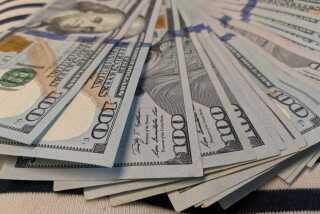Economists Adjust Their Views on Falling Dollar
- Share via
NEW YORK — Economists are getting more pessimistic about the benefits of the cheaper dollar.
Most experts still think the drop in the dollar’s value against other currencies will help shrink the huge U.S. trade deficit. But many say the shrinkage will be smaller and take longer to show up than they predicted earlier this year.
“The consensus has shifted a bit,” said David Wyss, chief financial economist for Data Resources Inc. in Lexington, Mass. “In the prevailing view, if anything, we’re a little behind schedule.”
The yawning trade gap frustrates politicians, business people and union leaders, who are waiting impatiently for the results of the sharp improvement in the dollar’s competitiveness.
The dollar dipped again Monday in Tokyo, hitting a post-World War II low of 159.25 Japanese yen. The dollar rose later in New York, where it hit 162.05 yen, up from 161.16 on Thursday. There was no trading Friday in New York in observance of Independence Day.
Stubborn Deficit
A cheap dollar is expected to help the U.S. trade position by making American goods less expensive overseas, thus encouraging sales, while at the same time raising the cost of foreign goods sold in the United States, cutting into buying by Americans.
However, the U.S. trade deficit has been more stubborn than predicted, and economists say there are two key reasons.
One is that Europe, Central America, the OPEC nations and some other key trading partners of the United States have weaker-than-expected economies and cannot absorb more American exports, even though the dollar’s slide had made them better bargains.
Another reason is that American buyers have taken longer than expected to switch from foreign to domestic suppliers. Foreign suppliers have slashed their profit margins to hang onto American customers.
“We’re still expecting improvements in trade this year, but they’re going to be slow and--at least for this year and next year--fairly moderate,” said David Berson, senior economist at Wharton Econometric Forecasting Associates in Philadelphia.
Pessimism Grows
The pessimism is widespread: In December, Chase Econometrics Associates in Bala Cynwyd, Pa., had been predicting the nation’s merchandise trade deficit this year would be about the same as 1985’s record $148.5 billion. Now it pegs the 1986 trade gap at about $165 billion.
Citing similar reasons, Wharton and Data Resources have both added about $10 billion since the start of the year to their projections of the 1986 merchandise trade gap.
Moreover, the trade deficit should remain above $100 billion a year until at least 1988 or 1989, most forecasters say.
More to Read
Inside the business of entertainment
The Wide Shot brings you news, analysis and insights on everything from streaming wars to production — and what it all means for the future.
You may occasionally receive promotional content from the Los Angeles Times.










